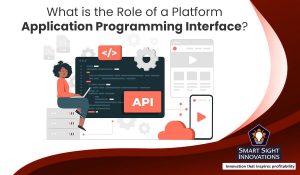 The API or application programming interface sets the rules for the creation and integration of application software. An interface allows products and services to communicate with each other, taking advantage of shared data and functionality with third-party developers, business partners, and internal departments. Web applications may not be possible without the API role.
The API or application programming interface sets the rules for the creation and integration of application software. An interface allows products and services to communicate with each other, taking advantage of shared data and functionality with third-party developers, business partners, and internal departments. Web applications may not be possible without the API role.
How do APIs work?
APIs have two associated elements:
- A specification that describes how information is exchanged between programs, in the form of requests for processing, and
- Returning useful data through a software interface for that specification, and published in a usable manner.
The software that wants to access the API features and capabilities is asked to “call” it, and the software that creates the API is asked to “publish” it. An API will dictate how two machines talk to each other.
APIs authorize and provide access to data requested by users and other applications. The access is authenticated to functionality, against pre-defined rules that control which services can access specific data or actions.
What is the API purpose?
A good API design is critical to successful API use. Software developers always review potential API applications and the most logical way to use them. An API’s purpose is to meet the following:
- The data structure and parameter values are of particular importance as they must match the caller of an API and its publisher.
- Security in API design must protect against cyber-attacks. API presents an organization’s systems and data to internal and external users. A compromise can create security problems.
- Create standard, reusable components and abstractions that are easily understood by the users. Abstraction helps to expose minimally relevant information to others.
- Create a reusable API to benefit the users and make it easier for the developers. A defined API scope helps in designing, testing, creation, management and versioning of components.
What is API integration?
API integration is the connection between two or more applications through their programming interfaces. It allows the system to exchange data sources. It drives processes across the organizational layers to keep data in sync, increase productivity, and drive revenue.
API is an integral part of everything in the digital world. No matter the nature and size of the business, APIs enable seamless operation and performance of applications and web systems.
API integration comes in when there is an added need to achieve optimal and automated business processes and actions that interact and share critical data.
Types of API
The four basic types of APIs include:
- Private APIs published internally for use by company developers to improve their products and services. The private APIs are not open to third-party exposure.
- Public or open APIs that are publicly published and can be used by any third party. There are no restrictions on the public APIs.
- Partner APIs may be used by specific parties with whom the company shares the data. It is used within business relationships to integrate software between partner companies.
- Composite APIs join multiple APIs to address related or interdependent tasks to improve speed and performance over individual APIs.
Types of API architectures
It helps to understand APIs in terms of their architecture also. The API architecture consists of rules guiding what information the API can share with the client and how it shares that data. The most popular API architectures in use today are:
REST
Most web APIs are built on REST or representational state transfer. It allows a scalable, lightweight and easy-to-use API. This API follows REST guidelines to transfer data from the server to the requesting client. The guidelines state:
- A client-server separation where all client-server interaction must be a client request, followed by a server response. The servers cannot request and clients cannot respond.
- Uniform interface, where requests and responses must use HTTP communication protocol format to ensure client-server compatibility. The server responses have JavaScript Object Notation (JSON) formats.
- Stateless form, in which each client-server interaction is independent of every other interaction. The server does not store client request data or anything from previous interactions.
- A layered system, in which requests and responses must be formatted similarly when passing through an intermediate server between the client and the API.
- Cacheable, where server responses must indicate if a resource provided by the client can be stored, and for how long.
SOAP
SOAP (simple object access protocol) transmits data over a network and can be used to create APIs. It uses XML to encode information.
SOAP defines how messages should be sent and what they should contain. Therefore, SOAP APIs are more secure than REST, and rigid guidelines make them code-centric and challenging to implement in general.
Therefore, SOAP is often implemented for internal data transfer that requires high security. The SOAP API works on any communication protocol, not just HTTP.
RPC
RPC (remote procedural call) protocol is the most simple of the three architectures. Unlike REST and SOAP which allow data transfer, RPC implements API processes. In simple words, they carry scripts on the server.
RPC APIs can use JSON or XML protocols in their calls. Although similar, XML is more secure and helpful than JSON. The RPC protocol is a strict, but relatively simple and easy way to execute code over a remote network.
The RPC APIs offer limited security and capabilities and are less common on the web. However, it can be used for internal systems for basic process requests.
How are APIs used today?
The connectivity that people enjoy today is API-driven. Many apps that you interact with daily are APIs with user interfaces. Almost every operating system or webpage includes some API. It is now common and requires only a web browser. Some popular API examples include:
Payment methods
E-commerce platforms allow customers to pay for their orders using third-party payment applications such as PayPal. In this, API connections provide payment services to the user without having to worry about leaving the e-commerce website or having their data fall into the wrong hands.
For example, when a customer clicks on the ‘Pay with PayPal’ button, an ‘Order’ request is routed from the platform to the PayPal API. It transmits the data on the bill securely. When the user authenticates, the API returns to the application with the payment confirmation.
Sign in using Google or Facebook
Many websites and applications give users the option to sign in using their Google or Facebook accounts. The buttons do not allow the website to access users’ Google or Facebook data. Instead, the service provider’s API verifies the user’s identity.
Each time the website or application is accessed, it uses Facebook or Google’s APIs to check if the user is already logged in. Other internet service providers such as Twitter and Apple also provide this functionality on some websites using API.
Twitter bots
Twitter bots are accounts that are automated on the microblogging website Twitter. These accounts use the Twitter API to auto-perform software-defined tasks of tweeting, retweeting, following and sending direct messages.
Bot makers use the Twitter API to set up their bots to perform simple tasks or be notified when a specific event occurs on the platform. For example, you can use the Twitter API to configure a bot to recognize when a new account follows.
Travel bookings
Several booking aggregator websites for flights and hotels assemble multiple options to offer the best deals to customers. APIs have a significant role in displaying the availability and pricing of flights and hotels. Once the user completes the booking on the website, API confirms the transaction with the service provider.
By allowing computers to rapidly exchange data, APIs have greatly simplified operations for the travel and tourism sector. Without APIs, booking services would require manual coordination which can be a long, tedious process.
To sum it up
API or application programming interface works in the background whenever two applications interact. From instant messaging to making purchases through online systems, they simplify user experiences. Hiring an software development company will help you with creating a API system specific for your brand.
APIs can help software deliver an excellent brand presence by combining third-party products or services. A good API with the right set of protocols can strengthen the technology architecture of an organization, making it the backbone of the entire organization.













